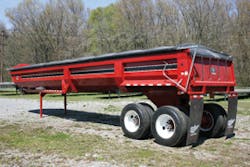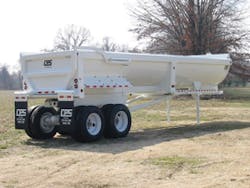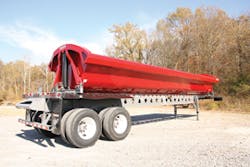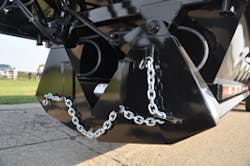Whether or not the flap of a pair of butterfly wings inevitably caused recent weather events will never be known, but what is known is that countless human lives were changed forever in October 2012 by a late season hurricane named Sandy-and by the painful aftermath. As power is restored, shattered lives repaired, and destroyed infrastructure hauled off before new projects begin, the critical equipment needed will be there in the background, as always.
End dumps find use in the clearing of debris and demolished materials, while bottom or belly dumps-lightweight, versatile, and quick-will put in place materials such as sand or asphalt to repair sites.
Dump trailers remain critical components of oilfield road-building operations in the midsection of the North American continent. But now with a multibillion dollar cleanup and rebuild about to start as soon as possible, they’ll be vital for efforts to bring some sense of normalcy back to the Northeast, too.
Great for Onsite Finishing Work Projects
Keith Limback, general sales manager for Manac USA, explains that earlier this year the demand for dump trailers, specifically bottom or belly dump trailers, went up. The firm manufactures using two brand names: Manac and CPS. The company’s bottom or belly dump is under the CPS name brand.
“That is our number-one-selling construction trailer,” says Limback. “The reason why is that it’s a lightweight design. It has a weight advantage that really makes it a great improvement for trailers in this. This has also been our most popular model over the last 12 months, and it is being driven mostly by the oil industry.”
Every new oil well pad needs a road. These trailers are very efficient at dropping road base, according to Limback. “Bottom dumps are also a very low-capital investment compared with end dumps. It’s very quick; you don’t have to back it up, lift a hoist, and you can drop the product while the vehicle is traveling, as well. This helps spread the material after it has been top-loaded.”
Dump trailers come in various sizes, shapes, and operating modes.
After pulling up to a road construction site, the driver will open the clamshell gate on the bottom, traveling at a designated speed to spread the material. The trailer is also used for laying asphalt. In addition to the low purchase price, the trailer can be pulled with any truck. You do not need hydraulics. The clamshell gate is operated pneumatically. It is efficient in terms of initial investment and makes for quicker operation.
“You could have this bottom dump unloaded before an end dump can even position itself to even lift the hoist,” says Limback. “The bottom-dump operator is already back to get another load while that of the end dump is just activating the hoist. Counties use if for maintenance on gravel roads, and you can actually spread gravel at 30 mph with this dump trailer.”
The Dakotas have seen intense use of the Manac bottom-dump trailer, and so have Texas and Oklahoma.They are constructed from special steel called Hardox, also referred to as AR450. This is exceptionally strong, hard steel that withstands the heavy blows of broken concrete, rebar, riprap and other demolition debris being dumped. “The construction we are seeing on highways today is more destruction than construction, to a large extent,” says Limback. “That is because they are just starting, tearing up concrete, dry docks, and preparing for reconstruction of the infrastructure.
The bottom-dump is the company’s largest seller. Half-round is the next largest seller, and the side dump is somewhat of a hybrid able to do what both the half-round and the bottom-dump can do. The half-round has the benefit of a curved bottom, able to absorb the shock of the materials dumped there, unlike trailers with flat bottoms, which receive much more of a shock. However, the drawback to that trailer is that it is heavier, limiting the amount of product able to be handled.
A new model, to be introduced in 2013, is an aluminum end-dump, more of a materials trailer. This will handle such things as sand and gravel. It is lighter in weight, enabling users to haul more payloads. A lightweight bottom-dump weighs some 12,500 pounds and has a 23-yard capacity. Manac’s half-round demolition trailer weighs 13,500 pounds, and the side-dump weighs 14,000 pounds.
“The capacity is very similar in all of these trailers,” Limback says. “However, you are restricted to the 80,000-pounds gross vehicle weight requirement; the heavier the trailer, the less payload in weight you are able to haul. The aluminum end-dump we are introducing weighs 10,000 pounds, and the idea is that, as an operator, you are probably going to travel a little bit farther with sand and gravel-from the pits to the construction site-plus, this way you can haul more in one trip with the lighter-weight trailer. However, this would not be a good trailer for demolition work.”
Lighter Trailers Key for Fuel Savings
The Landoll material handling trailers are all bottom-dumps; the company doesn’t build an end-dump trailer. Its trailers typically are in support of infrastructure activities where rock and sand are being moved, not demolition materials. Landoll leads the industry with the ultra-light series of bottom-dump trailers, explains Jim Ladner, Landoll national sales manager. The origins of the company go back to the use of a steel, 21-cubic-yard, bottom-dump trailer weighing less than 11,000 pounds.
“The objective of the ultra-light series is to enable the operator to maximize payload on each and every trip. Most of our customers work on infrastructure projects, either handling hot asphalt or laying down material in a windrow with the seamless asphalt process-seamless meaning that the paver never has to stop, but he’s continually rolling forward, and a bottom-dump in front of him just supplies the amount of material he needs to lay down in a windrow.”
This is extremely efficient and timesaving, as there is no need to stop and reload the hot asphalt. Hot in-place asphalt recycling seems to be a growing trend, more common in the South than the North, according to Ladner. “The ultra-light series is so important to someone getting paid by the ton-mile; they’re just in a rotational circle where he might be transporting 20 miles, making 15 trips a day.
“If he can haul an additional 1,000 pounds per trip, the series trailer pays benefits, and the return on investment is very quick. Most bottom dumps are going to weigh a couple thousand pounds heavier. Trips going from pit to plant, those are the places where he becomes very efficient, and in being paid by the ton-mile he’s all about hauling payload right up to that 80,000 gross. Every pound you take off your truck is another pound you gain in the hopper.”
Landoll developed its barrel-shaped design with its bridge-shaped truss construction. This design assists with cleanout operations as there are no flat surfaces for the material to hang up on. The bridge truss design also allows the trailer to be strong longitudinally in addition to making it durable with a long life cycle.
Complicating issues with dump trailers is the fact that states vary on the amount of payload allowed to be hauled on their roads. Kansas, for example allows 5,500 more pounds than Missouri. “Those are state regulations, not the federal guideline of 80,000 pound gross,” adds Ladner. “State highways will permit 85,500 pounds to be hauled, but not on the Interstate. It is critical to know your local state regulations and the routes you are going to be using.
“There is a whole scenario of challenges when you are in the trailer manufacturing business, because there are 50 different guidelines, rules, and regulations to try building trailers from, and then from an operator’s standpoint you’ve got to be very informed on the local regulations you’ve got to operate in.”
In order to ensure loads are accurate in order to cover all the different regulations, Landoll offers an onboard scale system, Airway. Operators of front-end loaders and drivers with the onboard scale system can come within 300 pounds of exactly what he’s going to put in that trailer on each and every trip. The scale system even has a light so that at an amount, say 500 pounds before it is full-before the maximum payload is reached-the light can come on so the operator knows to stop adding more material.
“If an operator knows that he’s gone to the exact amount he’s allowed to haul, coupled with the ultra-light series trailer, it ensures he gets every pound allowable moved on every trip,” explains Ladner. “The payback on the system is very quick for each and every trip; maybe it isn’t that big a deal if you’re going 2, 3, or 5 miles, but on 30- to 40-mile hauls it really pays benefits then, to haul every pound that’s legally possible. You want to minimize trailer weight and put it all into payload. Operators need to do their homework, and part of that homework is finding that ultra-light trailer to start with.”
It is more of an investment to purchase an ultralight trailer, but the payback is quick when you calculate the materials that you’re moving on each and every trip. Landoll does build heavyweight trailers for out in the mud, dirt, and being pushed on by dozers on the job site, but the growing trend is in ultralights hauling more payloads in each and every trip.
“We’ve had the best bottom-dump year we’ve had in several years because of the improving economy, helped by huge sales associated with activities in the oil industry,” Ladner says. “This drives a lot of opportunities in Pennsylvania, North Dakota, Texas, Oklahoma, and northern Alberta. In the cleanup with the recent storm, Sandy, the end dumps will be used in cleanup operations, but bottom dumps will come into play once the infrastructure work begins.”
With the ultralight trailers, users may choose to have a three-axle trailer. In Nebraska these are more common than two-axle trailers because their gross allowable weight is even higher than that allowed in Kansas. The gross in Nebraska is 92,000 pounds, according to Ladner.
“If an operator lives in northeast Kansas, he’s got three guidelines to deal with and has to figure out the best of all worlds to make things work. Kansas highways tend to contain more asphalt than Nebraska, where they use more concrete in the roads. These factors were determined years ago.
“I believe the economy is going to continue to improve,” Ladner says. “Events like Sandy just help get more foundations poured and bring more activity to this industry, and the cleanup and rebuild go on. It’s not going to help anybody in Florida, Arizona, or Nevada, where it’s still slow. This is a huge thing involving billions of dollars, but it’s also a highly regionalized thing.”
New Crossover Dump Trailer Available
Felling Trailers has a crossover that is more of a commercial-grade type of dump trailer competing with a side-dump or belly-dump in the market. With rental companies, contractors, and anyone else using dump trailers, the most popular of these products are those in Felling’s DTHD Line. Those range in capacity from about 10,000 to 16,000 pounds.
“I don’t know that there is anything that has changed in that product line over the last few years,” says Patrick Smith, Felling Trailers sales manager. “Our big-selling feature for that specifically is effective use of our extremely heavy-duty scissor hoist in that product line-anywhere from a 10-ton to a 15-ton scissor hoist, which is about double the capacity that is really needed. We do that to make it have a longer use life for our customer base.”
Felling Trailers has also added some different features, different tarp kits, and gap engine-type power options. The biggest thing that it has going on is in the 60,000- to 70,000-pound capacity, to be towed by a contractor with a semi-truck for road construction, the Crossover X-55 product. This unique trailer design is something constructed in conjunction with another company which is the patent holder.
“This creates a safer product. Dump trailers traditionally tend to be rather tippy, have a lot of accidents, and are hard to insure,” explains Smith. “We’re trying to develop a trailer product that keeps a majority of the weight over the center of the frame of the trailer all the time and can still dump the capacity that contractors are looking for. It’s a really new design.
With Terex articulated dump trucks the big thing right now is emission compliance as it relates to engine technology and fuel efficiency. “They’re able to do cycle times much faster while leaving a much smaller footprint on the environment,” explains Amber Reed, Terex spokesperson.“There is still a tried and true design that is working well,” she says. “What has really changed for the Terex dump truck line and for the entire industry—just because of the horsepower size and the category of the equipment it falls under—is simply that they’re not tier-four compliant and the things that have gone on with those engine regulations that have made the trucks more fuel efficient.”
They’ve reduced noise emissions, and because of the change in the engines they’ve been able to get more horsepower out of them, which means quicker cycle time. All of those things have been tied into the government emission compliance standards that Terex meets. The trucks have the right power-to-weight ratio, designed for maximum payload capacity, but then they give their trucks just enough power to handle that capacity.
Terex’s new TA400 Generation 9 Articulated Truck is designed to work on job sites ranging from sand and gravel quarries to coal mines and road construction projects, the new Terex TA400 Generation 9 articulated truck is designed to keep productivity levels high, fuel consumption low, and cycle times short. With a 444-horsepower Tier 4 interim–compliant Scania DC13 engine, the TA400 has a maximum payload of 41.9 tons and a heaped capacity of 30.3 cubic yards. With a world-class, emissions-compliant engine offering maximum torque of 1,548 foot-pounds at 1,350 rpm, coupled to a fully automatic Allison transmission through a two-speed drop box, the new TA400 provides both exceptional rim-pull and high-speed capabilities.
The new Generation 9 TA400 is equipped with dual retarder systems, a transmission retarder, and exhaust brake, giving operators increased control in loaded, downhill hauls. Engineered with a permanent all-wheel-drive (six-by-six) driveline and equalizing rear suspension, the new TA400 also offers exceptional traction capabilities. A four-bar trailing arm suspension system contributes to this new Terex truck’s exceptional ride quality, allowing operators to travel faster and more comfortably on difficult terrain.
“The combination of high torque, high horsepower, high capacity, and top speeds makes the Terex TA400 Generation 9 articulated truck a class leader in productivity,” says Ken Emmett, Terex product manager. “The new TA400 is engineered to provide maximum rim pull and gradability for negotiating inclines, and with its high range in the drop box for high-speed hauls and a large body capacity designed for high retention, this articulated truck offers customers an excellent cost-to-value ratio.
“Terex trucks and the engines have the right power-to-weight ratio balance,” adds Reed. “With the power they give their trucks and the designs they’ve given their trucks, they’re maximizing how much they can carry and how quickly they can do it with every load.”
“We’ve got four different types out doing demos going on at locations throughout the Midwest-and a fifth one coming offline as I speak, and the Minnesota DOT has actually purchase the first one of these from us. They are doing research on this with their experimental tech research program, and this will work out well for some of the asphalt-type projects.”
The Felling Trailer’s typical applications-despite its very broad product line-include home construction, landscaping, and demolition, along with related uses. Primary applications for Felling’s X55 Crossover include hauling materials such as riprap, clay, demolition, and a multitude of other materials that current bottom-dumps cannot haul.
Felling’s X55 maintains 70% of weight over the chassis. This product design greatly minimizes rollover issues currently experienced in the side-dump and end-dump industry.
The X55 also has the ability to dump “on the move.”
This trailer does not have to stop like other side-dumps or end-dumps on the market today, and it has the ability to dump at a higher speed than current bottom-dumps. Because of the weight distribution, the operator does not see or feel movement in the tractor while the X55 is dumping, either on the move or while stationary. Additionally, because of the weight distribution, the operator does not see torque in the kingpin.
The X55 has the ability to dump at 55 degrees and is capable of dumping product that might typically stick to the sides or bottom of the trailer. Felling Trailers range in size from 3,000-pound utility trailers to 120,000-pound hydraulic gooseneck trailers. The company has over 220 models.
Challenge of Building the Right Size
Ranco had been selling a lot more of the bottom dumps this past year until it saw the market swing somewhat, ending up with the year being strong for its end-dumps. Dan Webb, national sales and marketing manager for Ranco, sees end-dumps as being critical in the initial cleanup work and bottom-dumps entering the picture to complete the infrastructure and road rebuild and repair work in the wake of the recent storm.
Detail of bottom dump gates
Lamar, CO-based Ranco has been around for many years and is a premiere brand of end- and bottom-dump trailers alike, according to Webb. “Our biggest focus going forward is trying to forecast what we may see coming down the line as far as the different variations of length of trailers in the bottom-dumps and end-dumps we have,” explains Webb. “We make both a single-point suspension and an air ride with an airlift axle suspension. Getting a load measurement on a single point has always been a little bit more challenging, and we’ve come up with a company that does provide some trunion load cells for the single-point suspension to help the owner-operator know exactly what his load is weight-wise.
“We use the AR-400 metal in the construction of our trailers. This is an abrasive-resistant, quality steel. This makes for a quality product at the end of the day.”
Ranco’s bottom-dumps are V-shaped, hopper-type trailers. End-dumps are half-round and frameless. On the company’s tandem end-dumps, all four tires remain on the ground through the dumping process.
Ranco does not want to see lead times re-grow, according to Webb. It would like to keep them fairly short so that the company can be responsive to the customers’ needs of delivery. Keeping up-with enough inventories on the ground or in the pipeline to meet the challenge of supplying customers-is the primary goal.
Dealing with the aftermath of hurricane Sandy may stretch that goal to the limit as well as presenting unique challenges to all dealing with manufacturing, sales, supplies, maintenance, and everyday use of dump trailers in the coming months.







